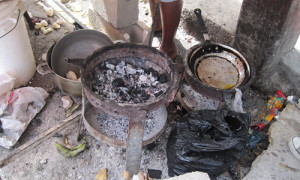Continued from Part 1 and Part 2…
During those three months in Haiti, I never experienced physical or verbal threats. I even pushed the limits. I took risks I probably shouldn’t have, especially walking the streets alone at night. One night, I returned home alone just after 10pm, almost four hours after the sun had set. This was long past when most houses in my neighborhood were already tightly secured with many already asleep inside. Perhaps I felt relatively safe because of the “type” of neighborhood I was living in and walking through. Many homes in that middle class area were not only surrounded by concrete, metal or stone gates but they also had uninterrupted access to water – sometimes running, sometimes not. While many relied on city electricity, those that could afford to do so (as was the case where I was staying) supplemented this unstable power source with inverters or generators.
While my social science training often pushes for broader identification of class from a top-down, macro perspective, pinpointing class status on an individual level is much more difficult. This was the case with Jeff, one of my housemates who was always eager to take me for walks around the neighborhood. His own tastes and tolerances, as a 24-year old, signaled for me that his class standing hovered somewhere between working and middle class. And yet, he insisted on aligning himself with those of the lower class, or klas anba. In one sense, he was right – at any given moment he could claim to be broke (raze). And yet, there were signs of klas moyen (middle class) in his behaviors: his willingness to eat only some forms of street food and not others and his carefully put together gangster-esque style of clothing: themed T-shirts, baggy pants revealing boxer shorts underneath, and an (often) sideways placed cap – the one proclaiming his allegiance to the Brazilian foutbòl team. The conditions of his unemployment, in my mind, were a major factor that set him apart from the poorest residents of the city. It was a product of a general lack of jobs in the country, to be sure. But it was also partly due to his unwillingness to engage in most forms of manual labor, and also a result of the fact that it wasn’t really necessary for him to work. He had all his immediate needs taken care of – food, clothing, the occasional beer with friends, fees (paid by family) to attend driving school. He lived at his aunt’s house (my pwopriyetè, the landlord where I was staying) in a little one-room cement shack behind the house. He was provided with food whenever it was available, and he received some financial assistance from his mother who lived an hour outside the city. Thus, despite his insistence on belonging to the klas anba, there appeared (to me) to be a clear line between what he identified as ti pòv – the truly impoverished – and his own lifestyle.
Discussing issues relating to class identification and the differences between class divisions in the U.S. and Haiti was always a trying endeavor for me. While it was rare to engage in a direct conversation about class with those I met in Haiti, most weren’t exactly forthright in asking me questions about American culture and society either. Those moments when life in the U.S. did come up, I felt implicated in an unstated quest to identify Haiti’s flaws by turning to the U.S. as a “model.” One evening, while strolling around the neighborhood with Jeff and another young man in the house, the two of them began ranting about those aspects of Haitian society they didn’t like, with the availability of electricity being one point of discussion:
“Èske gen blakawout ozetazini?” Jeff inquired.
“Wi, blackouts happen once in a while in the U.S.,” I responded, “but not often.”
Turning to our other companion, he stated:
“Ou wè, li pa nòmal. Ayiti gen blakawout chak jou.”
I cringed at having taken part in this comparison, one that set the U.S. as the standard of what was “normal” for having near-constant electricity against which Haiti could be nothing but “abnormal” for having intermittent blackouts every day. And so, whenever possible, I made attempts to balance out the overwhelmingly positive associations people had of the U.S. with some negative aspects. As an anthropologist, cultural relativity is my moral code. But in those moments, I attempted to force a bastardized form of cultural relativism into conversations; in the process, I over-compensated with my sensitivity to the assumptions many Haitians had about my country.
In reality, cultural relativism remains an ideal, a near-unattainable idea. Perhaps it’s an idea that can only really exist in theory, with real-time interactions tending to be saturated with judgments, stereotypes, and assumptions. We can’t ignore the constant cross-cultural exchange of ideas taking place in countries like Haiti, a country supported by diasporan remittances and penetrated by multinational corporations, the international aid industry and a global circulation of cultural artifacts, particularly in the form of the entertainment industry (such as music and movies). Just as I was forming an understanding of Haitian culture through observation most Haitians I came into contact with had pre-existing ideas of my own culture and of American society in general. For many, the image they had was one that included idealized notions of American prosperity. How does one explain that poverty does exist in the U.S. and life is difficult for many? I’ve heard it said that it’s easier to live an impoverished life in Haiti than it is in the U.S. If this is in fact true (which is hard to say), it could be the result of strong social networks in Haiti coupled with a sense of obligation to family and friends. Of course, the most obvious explanation is the general cost of living. Depending on what one determines as “needs” and acceptable living conditions, it is possible to live on less in Haiti, especially with the help of friends and family.
The difficulty of explaining the financial stress of life in the U.S. was one I shared with a diasporan returnee. We met one day during my visit to the small town of Montrouis, a coastal village known for its beach resorts – namely the old Club Med now known as Club Indigo. As a petty merchant and friend of my host, he offered me a Coke, assuming it would be my beverage of choice. A portly man of about 65 years, he proceeded to tell me his story: The 20 years he spent in Miami working for a large airline corporation and his decision to return to Haiti after retiring. The benefits he received from retirement were just not cutting it in Miami. The worst part, he explained, was that people never believed him when he tried to explain how hard it can be living in the U.S. They always accused him of lying, he said, assuming he was selfishly trying to prevent others from succeeding in the way that he himself had – as if success were a limited commodity. We eagerly traded stories – bouncing between Kreyòl and English – about the encounters we had in trying to convince people of the reality of poverty in the U.S., especially for poor immigrants.
In her ethnographic exploration of a Vodou mambo (a priestess) traveling between Brooklyn and Haiti, Karen McCarthy Brown insightfully reflects that, between diasporans and those who remain in Haiti, there is strong interest on both sides that work to perpetuate the image of the U.S. as filled with opportunity, ready for the taking:
People on both sides of this arrangement have a vested interest in preserving fanciful stories of the opportunities available in New York. For those who stay behind, stories of the good life in the United States justify their sacrifice. Those who emigrate do not challenge these stories, for fear the disparity between dream and reality will be attributed to a lack of effort or caring on their part.”1
What needs to be taken into consideration – what serves as a backdrop in constructing the filters through which people make comparisons and interpretations – is the image many Haitians receive of the U.S. and other so-called “first world” countries. The family I lived with, for example, preferred watching sports on television, especially soccer. Next to sports, women tended to gravitate towards French-dubbed soap operas drawn from Brazil or the Dominican Republic or U.S.-produced television dramas (such as Charmed or Desperate Housewives). Men, on the other hand, particularly enjoyed action films, many of which originated in the U.S. Most, if not all the foreign-based television choices, carefully maintained the image of a comfortable and privileged life of plenty.
Music videos were also a popular choice, including a mix of Haitian and American songs. The popularity of watching these videos was the hardest for me to grasp, especially since family members would happily sit for hours, watching the same music videos over and over again, electricity permitting. It wasn’t even necessary to understand what musicians were singing about. Subtitles were almost never provided for songs that were in English. Regardless of whether people understood the lyrics, many could recite them in approximate terms. Having two 8-year-old boys sing Rihanna’s “Rude Boy” while following me most of the way home one afternoon was a particularly interesting (funny? troubling?) experience:
Come here, rude boy, boy; can you get it up?
Come here rude boy, boy; is your big enough?
I inquired if they understood what they were singing. When prompted to explain it to them, I quickly responded that it wasn’t a song for timoun (children). My discomfort at the prospect of explaining the lyrics to them influenced my response even as the circulation of images and ideas had motivated me to engage them in the first place.
Sitting with the pwopriyetè and her niece (Carline) one afternoon, American culture became the focal point of discussion. They were both working to prepare Sunday’s lunch. A sauce was boiling while the pwopriyetè cleaned and sorted vegetables. Carline was slowly adding seasoning, small meatballs, and other ingredients to the sauce. We were seated outside, around a hand-crafted, characteristically Haitian, 3-legged charcoal stove.
Carline, in her curious, yet shy and always friendly manner, inquired about the use of charcoal in the U.S.: Do Americans use charcoal? I hesitated, viewing the issue as a sensitive one. Because of an over-reliance on locally made charcoal in an already severely deforested country, many (Haitians and non-Haitians) have pointed a finger at Haitian cultural habits. That is, by not changing individual habits, the majority of Haitians are implicated in the country’s deforestation woes.
I couldn’t lie, but I also wanted to avoid perpetuating the idea of Haiti as “backwards” by giving the impression that the use of charcoal was somehow abnormal. I settled with a quick “sometimes” answer, imagining American families gathered around the charcoal BBQ. I knew, of course, full well that, for most Americans, this was only an occasional practice that required special equipment and planning.
The pwopriyetè jumped in to explain, arguing that most food in the U.S. comes in cans anyway – already prepared. What use was there to slow cook food over charcoal? While she certainly painted a simplistic picture of American eating habits, could I really argue with her? And how would my response be interpreted? If Brown is correct in noting that “neither of us is more correct than the other; we simply start from different places” (1991:181), then I would add that there can never be just one truth, as everything is a matter of perspective. While the details might have been wrong in a literal sense, the general point she seemed to be making was one I couldn’t argue with. Americans do indeed rely heavily on packaged and prepared food. Would explaining the details be more effective than allowing the generalization to slide? In many social interactions, we never really get the opportunity to explain ourselves completely or, conversely, to understand others completely. And even in those rare instances when we try, there’s no guarantee of success. Both sides are constantly working with assumptions that are simultaneously flexible and difficult to overturn.
As an anthropologist, the goal is to deliberately step outside of one cultural habitus – as Bourdieu (1977) would say – in order to attempt an occupation of another. In the process, we are forcefully made aware of the fact that we too, occupy a particular – and perhaps peculiar – habitus. That is, our observations and reflections on a different culture bring more forcefully into focus our own cultural habits and norms. The habitus that I had consciously and unconsciously learned throughout my life – always anchored in one mid-western American context or another – was over-turned and brought into question once I entered this foreign cultural context. What was normal in one situation – my unassuming whiteness – was unavoidably a marker of difference in this one. While I was fully prepared for this “culture shock,” what I wasn’t prepared for were the many assumptions most Haitians had about me and my cultural habits. And it always seemed as if no matter how hard I pushed back, I couldn’t make a dent in those assumptions. My comfort zone was forcefully overturned as I tried to regain my sense of individuality in an environment in which my being and presence were always already understood in ways I had little or no control over.
1 Karen McCarthy Brown, “Mama Lola: A vodou pristess in Brooklyn” (2001), pg. 181.↩




